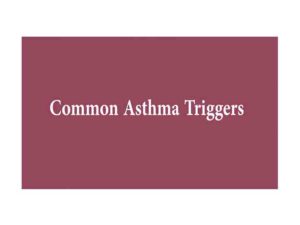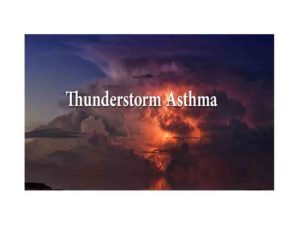Asthma Preventive Strategies
There are two basic types of asthma. Allergic (caused by exposure to an allergen) and nonallergic (caused by stress, exercise, illnesses like a cold or the flu, or exposure to extreme weather, irritants in the air or some medications).
Asthma Symptoms include
Coughing
Shortness of breath
Chest tightness
Wheezing
Common Asthma Triggers
Asthma triggers include substances which will trigger asthma symptoms. These include both irritants and allergens. Asthma triggers are found almost anywhere and everywhere. Identification of irritants and allergens are very important in an asthma patients as avoidance of these substances lead to better control of asthma symptoms.
ASTHMA TRIGGERS
Animal Secretions
Animal Secretions are important source of allergen which can trigger asthma symptoms. Secretions from cats, dogs, horses, rabbits and other furry animals act as allergens.
Avoidance Measures:
Measures to reduce the level of allergens include-
- Remove pet from the home.
- Limit exposure to the pet.
- Bathe pet regularly; delegate when possible.
- Vacuum floor and furniture thoroughly.
- Remove carpets if possible.
Cockroaches
Cockroaches are common insects. They live in the home, school or workplace. They mainly thrive in wet areas, where food waste has not been removed.
Avoidance Measures:
-Remove garbage from kitchens and bathrooms.
- Clean up all food crumbs or spilled liquids immediately.
- Wash dishes, cooking equipment and counters promptly after use.
- Keep counters, sinks, tables and floors clean and clear of debris.
- Seal cracks and openings around or inside cabinets.
- Store garbage in covered containers.
- Employ professional eradication service.
Dust mites
Tiny microscopic creatures that feed on the flakes of skin that people and pets shed daily.
Dust mites love humid, warm areas. There are large concentrations in bedrooms (pillows, blankets, carpets/ rugs, mattresses, stuffed animals, upholstered furniture, duvets, sheets).
Avoidance Measures:
Dust mites cannot be totally eliminated. However, the number of mites can be reduced by following prevention strategies.
- Maintain relative humidity level <50%. (A hygrometer is a useful, inexpensive device for measuring and monitoring indoor humidity levels.)
- Use vacuum with HEPA filter.
- Encase mattresses and pillows in dust-mite resistant covers.Wash all bedding in hot water (55-60°C) weekly.
- Freeze non-washable items (quilts, stuffed animals) in freezer or leave outside overnight in freezing temperatures.
- Remove stuffed animals from bedroom.
- Replace (if possible) carpets, rugs, heavy draperies and upholstered furniture.
Exercise
Physical activity can trigger asthma symptoms and may be a sign of uncontrolled asthma. Physical activity can lead to Exercise Induced Asthma (EIA) or Exercise Induced Bronchospasm (EIB).
Avoidance Measures:
Consider venue, time of day and weather conditions when planning activities.
- Warm-up exercise before and after physical activity. (5-10 minutes warm up to 60% of maximal heart rate)
- Prophylactic use of bronchodilator medication 10-30 minutes prior to activity.
- Elite level athletes must consult specialist for testing and advice.
Mould Spores
Spores are airborne.
Common indoor areas include: showers, bathrooms, window sills, laundry rooms, kitchens, refrigerators, garbage containers, carpets, upholstery, attics and basements.
Avoidance Measures:
Maintain relative humidity level <50%.
- Promote air circulation with and use of vents and fans.
- Clean showers/bathtubs after each use to prevent mildew.
- Clean mouldy surfaces with a water and bleach-based product.
- Wear mask and gloves to limit exposure when cleaning.
- Remove carpet from humid areas.
- Discard any mouldy items when possible.
- Repair any leaks and moisture problems promptly.
- Use dehumidifier in basements and crawl spaces.
- Avoid musty smelling areas (cottages, basements, garages, attics, etc.).
- Consult professional service for removal.
Pollen
Pollens are tiny, invisible particles given off by trees, grass, flowers and certain weed. Pollens are at their peak at various times from early spring until the first fall frost. It can be helpful to identify which pollen(s) is the allergen.
Avoidance Measures:
Close windows overnight to prevent pollens from drifting into the home.
- Use air conditioning to cool, dry and clean the air in the home.
- Minimize early morning outdoor activity when pollen levels are
Highest.
- Close vehicle windows when travelling.
- Avoid outdoor activities on windy, dry days when pollen and dust are blowing around.
- Dry laundry indoors to prevent pollens from adhering to linens and clothing.
Environmental Tobacco Smoke (ETS)
ETS is found in any area where people smoke cigars, cigarettes, pipes or marijuana.
Avoidance Measures:
- Promote, encourage and support smoking cessation
- Avoid second-hand smoke and active smoking.
- Prohibit smoking in the home of the affected person.
- Prohibit smoking in vehicles




